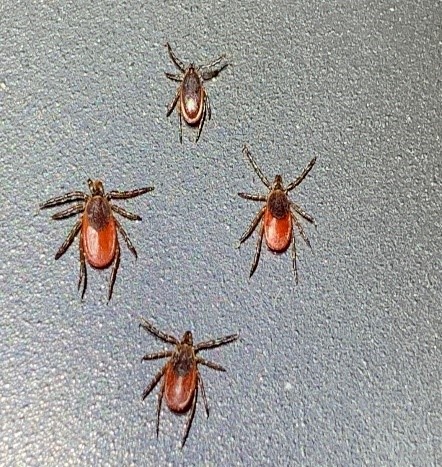MEDIA CONTACT
Jeff Powell, (402) 471-6223, jeff.powell@nebraska.gov
Emilee Longuski, (402) 385-4770, Emilee.Longuski@WinnebagoTribe.com
Julie Rother, (402) 375-2200, Julie@nnphd.org

Lincoln, Neb. – Recently, the Department of Health and Human Services (DHHS) was notified by the Northeast Nebraska Public Health Department of two cases of Lyme disease locally acquired within their jurisdiction. Both patients reported likely exposure around the same timeframe at sites located near one another in Thurston County.
Due to the association between both cases, a coordinated environmental investigation involving DHHS, the Northeast Nebraska Public Health Department, and the Winnebago Public Health Department was completed at the suspected exposure sites. Ixodes scapularis (commonly called deer tick or the blacklegged tick) were collected from the sites of likely exposure.
Thurston County is now the fourth known county (Douglas, Sarpy, and Saunders were identified in 2019) in the state to have established black-legged tick populations. A subset of the ticks collected was sent to the CDC's Division of Vector-Borne Disease and Creighton University for testing in an attempt to detect pathogens vectored by the tick including the bacteria (Borrelia burgdorferi) responsible for causing Lyme disease.
Ticks submitted to Creighton University and CDC came back positive for Borrelia burgdorferi indicating that the bacteria that causes Lyme disease is circulating in the tick population in the area. These results mark the first ever detection of Borrelia burgdorferi in Nebraska's blacklegged tick populations and the first definitive evidence of Lyme disease cases acquired locally in the state.
The detection of an established population of black-legged ticks in Nebraska with evidence of detectable pathogens heightens concern of further establishment of the tick vector and its associated pathogens in other areas of the state. DHHS will continue to work with the Northeast Nebraska Public Health Department, the Winnebago Public Health Department, and other state public health partners on surveillance efforts for blacklegged and other medically important ticks.
While tick activity may be slowing down with colder weather, blacklegged ticks can be active year-round. There are simple steps people can take to protect themselves against tick bites.
Prevention steps include:
- Use an EPA approved insect repellent containing DEET, picaridin, IR3535, oil of lemon eucalyptus, para-menthane-diol, or 2-undecanone.
- Treat clothing and gear such as boots, pants, socks, and tents with products containing 0.5% permethrin.
- Dress in long-sleeved shirts, pants, and socks when outside.
- Do frequent tick checks after being outdoors and remove attached ticks promptly with fine-tipped tweezers. Don't forget to check pets for ticks after being outdoors as well.
- Shower as soon as possible after being outdoors.
Ticks are generally found near the ground, in brushy or wooded areas. They cannot jump or fly. Instead, they climb grasses or shrubs and wait for you to brush against them. This is called “questing". When this happens, they hang on to you with small claws and then find a spot to attach and take a blood meal.
What to do if you find an attached tick:
- Remove the attached tick as soon as you notice it by grasping with fine-tipped tweezers, as close to the skin as possible, and pull it straight out. Early removal can minimize and often eliminate the chance of infection. After removing the tick, thoroughly clean the bite area and your hands with rubbing alcohol or soap and water.
- Avoid using nail polish, petroleum jelly, or heat to make the tick detach from the skin. These methods are not effective and may increase the risk of disease transmission.
- Watch for signs of illness such as rash or fever in the days and weeks following the bite, and see a healthcare provider if these develop. Be sure to let your healthcare provider know you were recently bitten by a tick.
For more information visit the following links:
CDC Ticks Website: https://www.cdc.gov/ticks/index.html
CDC Lyme Disease Website: https://www.cdc.gov/lyme/index.html
CDC Preventing Ticks on Pets Website: https://www.cdc.gov/ticks/avoid/on_pets.html
DHHS Press Release, “Blacklegged Tick Identified in Nebraska: https://dhhs.ne.gov/Pages/Blacklegged-Tick-Identified-in-Nebraska.aspx
 Image. Four (3 female; 1 male) Ixodes scapularis (black-legged ticks) collected from two exposure sites. The male Ixodes scapularis is located at the top of the image with the three other ticks being female Ixodes scapularis. Photo courtesy of Jeff Hamik (DHHS).
Image. Four (3 female; 1 male) Ixodes scapularis (black-legged ticks) collected from two exposure sites. The male Ixodes scapularis is located at the top of the image with the three other ticks being female Ixodes scapularis. Photo courtesy of Jeff Hamik (DHHS).
# # #